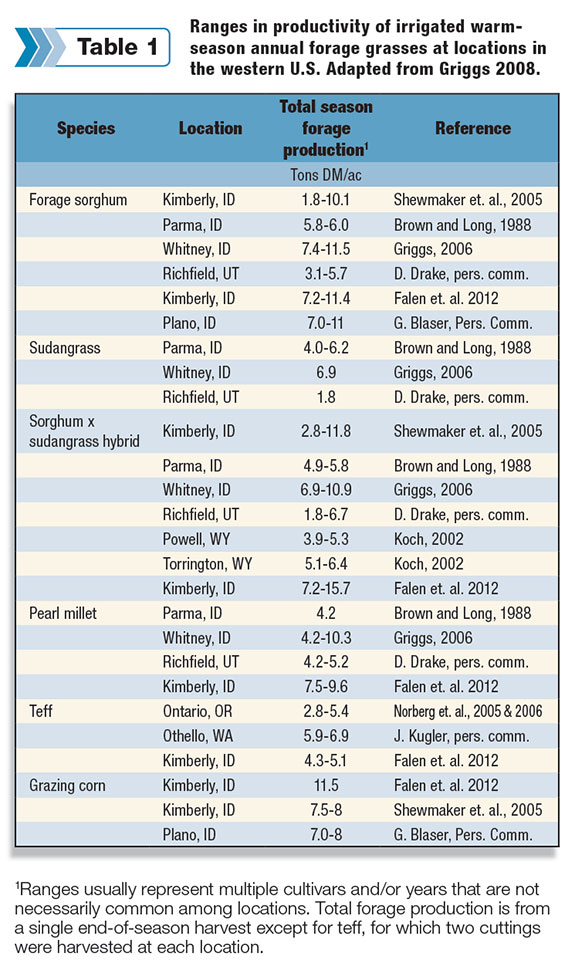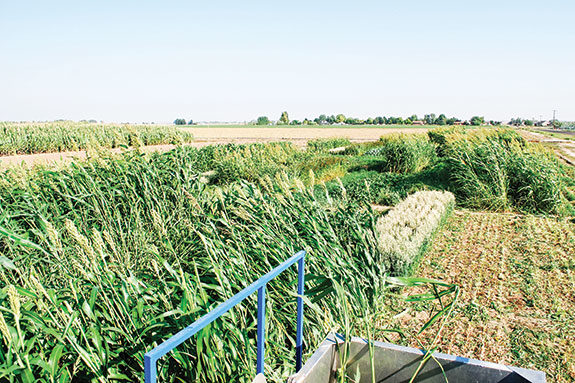Warm-season forages also may fit comfortably in crop rotations, especially in years when irrigation water is in short supply, and provide a good forage source while rotating out of perennial forages.
Annual forages can also be used as “double crops,” either for harvesting or direct consumption by livestock to extend the grazing season.
Warm-season forages like hot summers but will not produce much in cool periods, in contrast with cool-season forages. We will discuss the advantages and disadvantages of warm-season forages on irrigated areas of the northwestern U.S.
Producers should select the type or variety of warm-season forage to be grown based on adaptation of the species to the intended use, yield potential and feeding value for a particular livestock program.
There are differences in growth rate, recovery after clipping, forage yield and quality, plant height and leaf:stem ratio.
Forage sorghums and foxtail millets are best used for single-cut greenchop, silage or hay crops. The sudangrass, pearl millets and teff regrow adequately if sufficient stubble remains after cutting or grazing and may be harvested several times per year.
Once a species and variety are chosen, then make sure you manage the warm-season forage to meet your needs.
Annual forages are often used as emergency crops during droughts. However, they should be a planned part of the forage system and not simply grown in response to dry conditions.
There is no magic crop that produces much forage in less than 60 days. Most annual forage crops are more satisfactory for pasture or silage than for hay. Annual forages have the following advantages:
• Quick source of forage – within one season
• Rapid payback on establishment costs
• Breaks disease and pest cycles in crop rotations
• Allows quick response to changing economic and production conditions
• Versatility to graze at peak quality, ensile or stockpile for fall/winter grazing
• High water use efficiency and nutrient uptake potential
• Potential to double-crop in lower elevations or latitudes
Disadvantages:
• Soil temperatures need to be above 50º to 60ºF and no frost after planting.
• Growth will stop with the first frost.
• Forage quality is generally lower than cool-season forages at the same maturity.
• The planting and harvesting windows to obtain the highest forage quality are more narrow than cool-season forages.
Warm-season annual forages include corn, forage sorghum, sorghum/sudangrass hybrids, pearl and foxtail millet, and teff.
Within the sorghum family, the sudangrass and sudangrass hybrids are rapidly growing annuals with medium yields and are well-suited for grazing. The regrowth is rapid after harvest, allowing several harvests during summer and early fall.
Sorghum/sudangrass hybrids are more vigorous and higher-yielding than sudangrass; however, there is more potential for toxic levels of prussic acid.
The sorghum forages are best used when grazed, greenchopped or harvested for silage because they are difficult to cure as hay.
Horses should not be allowed to graze sorghum forage. Do not graze stressed, wilted or sorghum plants with young tillers.
Do not graze when frost is likely or after a killing frost until the plant material has dried substantially to reduce the potential of prussic acid poisoning.
Forage sorghum, sudangrasses and sorghum/sudangrass hybrids are better adapted than most species to drought, high temperature and waterlogging but will yield less in seasons with cool (less than 85ºF) Augusts.
Sudangrass and sorghum/sudangrass hybrids should be harvested at two to three feet of height if the plan is to take two to three harvests during the season.
Harvesting at later maturity may increase yield but will result in very low forage quality. So fall/winter stockpiled sudangrass for grazing will most likely require protein supplements.
Foxtail millet is a small-seeded, fast-growing summer annual grass with stems and leaves more like cool-season grasses than the sorghum-type forages.
Pearl millet looks like sorghum. Millets require a stubble height of 6 to 8 inches or they will not regrow very well. Yields may be slightly less, but they do not have a problem with prussic acid poisoning.
The millets are easier to harvest as hay and work well for grazing. Pearl millet stays standing in snow.
Teff is a fine-stemmed warm-season grass which can be used for grazing, horse hay, to double-crop or as a rotational crop with alfalfa.
Teff is palatable to grazing livestock while it is in the vegetative to boot stage, but quality and preference decline rapidly with maturity.
Forage yield
Forage yield of warm-season grasses is highly dependent on the environment, agronomic management and the genetic potential of the plants.

There is a lot of variability in reported yields (Table 1) across different years, climates and within a site.
We have updated a table to include more sites and years in Table 1.
The ranges of yields are given rather than the averages because producers need to be aware of the variability in yields from year to year.
Most of the reported studies involve several varieties within a species, several replications and from two to five years of data.
University of Idaho studies have recorded yields from 7.5 to 11 tons of dry matter per acre with forage sorghums on irrigated production in south-central Idaho in recent years.
We have also observed bird and rodent damage from eating the seeds or seedlings in small plot studies.
Producers who want extended grazing should consider warm-season forages that will stand up under snow.
Grazing corn, some of the sorghum x sudangrass varieties and the millets will remain partially accessible in a snow crust and preserve better than teff.
Oklahoma State University reports that a total of one-half acre per animal has been sufficient to feed a cow for 120 days utilizing strip grazing.
They report that mature cows will gain about one pound per day in December, one half-pound in January and none in February because the forage quality deteriorates.
University of Wyoming studies show that an acre of sorghum/sudangrass will provide 180 to 250 grazing days for mature cattle (i.e. 2½ to 3½ head for 70 days) on irrigated fields.
University of Idaho studies estimate a range from 69 to 532 animal unit days per acre, assuming a 50 percent grazing efficiency.
Producers who don’t strip graze should expect to utilize less than 50 percent of the forage produced compared to 60 to 70 percent utilization with strip grazing.
Forage quality is largely determined by the stage of maturity of the forage and declines as yield increases. Forage sorghum should be harvested for silage at milk stage.
Warm-season forages yield well in warm years and poorly in cool years. Although they can be successfully grown at high elevations, the potential for cooler weather and reduced growth or frost that would cease growth is high.
Sorghum forage quality is influenced by numerous factors including harvest stage, the development of the brown midrib (BMR) trait and other factors.
The BMR trait provides improved digestibility and animal performance from sorghum forages. The brown midrib trait reduces plant lignin; thus breeders have been challenged to develop hybrids with adequate standability for most production systems.
Numerous studies have shown brown midrib advantages in digestibility, and animals choose brown midrib forage when offered a choice between brown midrib and conventional hybrids.
Summary
• Warm-season forages will yield more than cool-season forages when planted in mid-summer.
• Corns, sorghums and crosses will cease growth with the first frost.
• Cool-season forages continue to grow after the first frost in the fall and will grow again in early spring, unlike warm-season forages.
• Strip grazing of forages will provide a more uniform plane of nutrition and increased grazing days.
• Use feed tests so you know what you have in the forage and what you need to balance the ration.
• Test for nitrates in forage that is stressed by drought, hail, high fertilizer or manure rates, or frost.
• Graze sorghums, sudangrasses and hybrids after they reach two feet and monitor the prussic acid content. Ensiling removes the prussic acid concern. FG
Christi Falen is a Lincoln County Extension educator with the University of Idaho.
References omitted due to space but are available upon request. Click here to email an editor.
Glenn Shewmaker
Extension Forage Specialist
University of Idaho – Kimberly R&E Center










